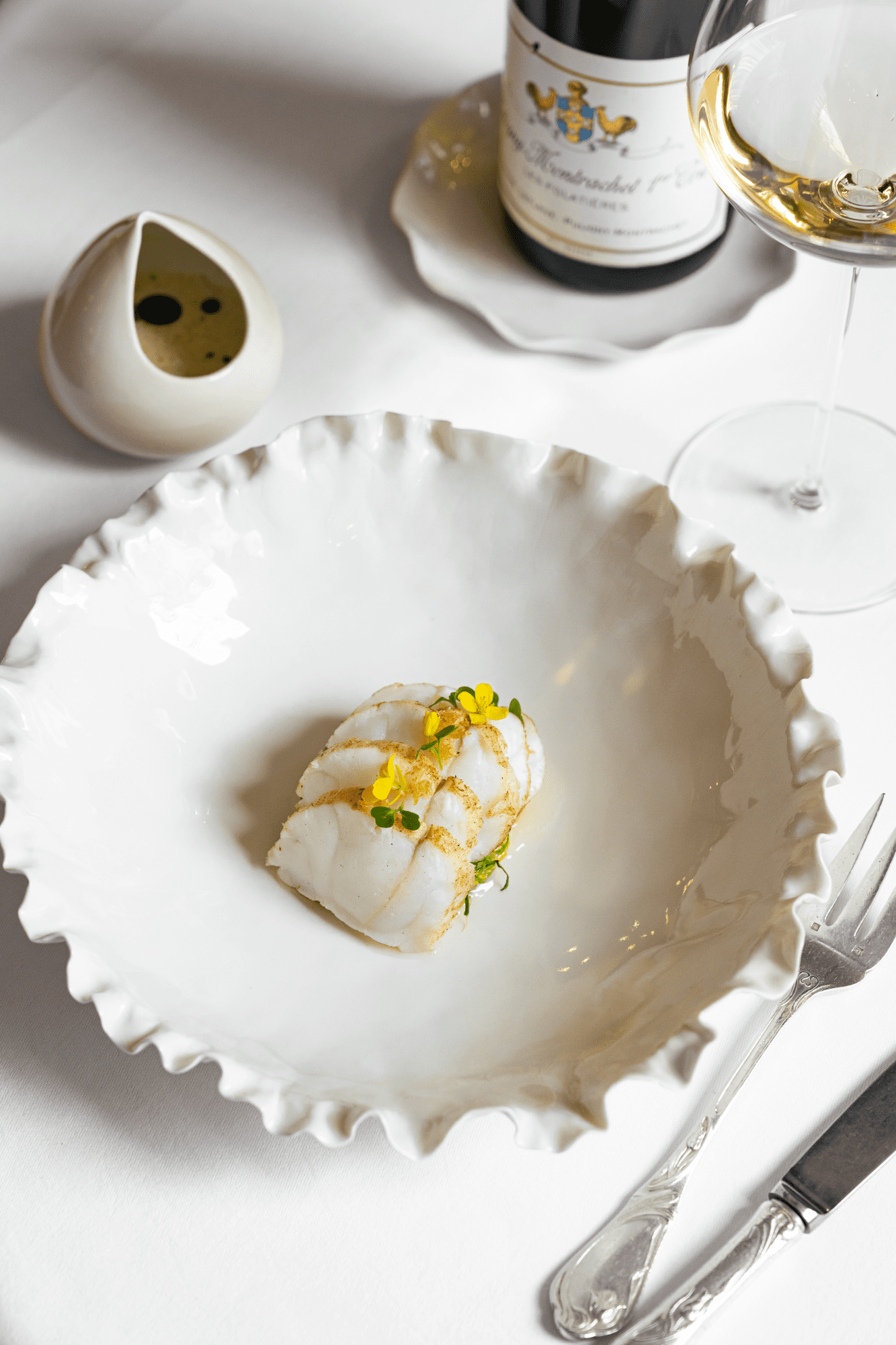menu
News #16
News #16

From earth to plate: a plant, a dish and a wine, Hugo Bourny has created a tribute to the Puligny-Montrachet terroir. To be enjoyed at Lucas Carton!
Hugo Bourny selected hawthorn from the day's harvest to create a new dish for the restaurant's menu. “Lucas Carton is a Domaine Leflaive club member, and I'm a big fan of the wines myself, explained the chef. Discovering the richness of the local flora was very exciting. We spotted a lot more wild edible herbs than I'd imagined, so I had the feeling I didn't know very much!" His singular culinary approach was built around hawthorn: "I mixed it with a little butter and left it to infuse. The result was interesting, so I looked for an association, in this case with monkfish, which I smoked with a little juniper wood, also found in the Puligny-Montrachet vineyards, and matured for several days. I added miso for extra power.
That's how a recipe is created and finds its way onto the menu. "It's one of the two that moves the most our customers," says Hugo Bourny, who asked his sommelier, Michel Le Meur, for the best wine pairing: Les Folatières in the 2014 vintage, replied the expert. “The vines of the Puligny-Montrachet premier cru are also rich in the biodiversity that Domaine Leflaive seeks everywhere. Organic and biodynamic viticulture is decisive, said Thierry Thévenin. In the conventional vineyards I've been able to survey, there are only two or three species left, which are ultra-resistant and unpalatable. In the estate's vineyards, around fifty different species can coexist, offering a highly diverse range of edible and medicinal plants. The flora brings balance to the vineyard and makes it a living environment!”
« Matured and smoked monkfish, hawthorn and miso broth, horseradish-fresh pointed cabbage »
Available at Lucas Carton restaurant until early summer: https://www.lucascarton.com/accueil
@lucascartonparis @hugobourny

Expressing the sensoriality of Domaine Leflaive: an original approach with painter Caroline Besse!
How did you proceed?
The aim was to reveal the mineral and plant chromatic identity of the estate. With the help of geologist Françoise Vannier, I began by collecting minerals of different colours from the Puligny-Montrachet parcels. I ground and crushed the minerals, which I then sieved. I also collected the vegetation present in the plots - the vines, of course, but also some flowers, plants and trees with which it was possible to make vegetal inks. I then proceeded with the decoction and the cooking of the plants to obtain the inks. In this way, I created colour charts of the minerals and vegetal, both on paper and in bottles filled with the raw materials.
What was the next step?
Using the estate's colours as a starting point, I made a series of graphic proposals to evoke the Puligny-Montrachet terroir in sensitive terms: what shapes, what colours came to me in the moment of tasting and contemplating the landscape. Sensations of movement and intensity that suggest images and graphics. I wanted to express the sensoriality of the estate, linked like a synaesthesia between sight and taste.
Are you particularly inspired by the world of wine?
I was delighted to be asked to work directly with minerals, to explore the colours of the subsoil in a territory as significant as Domaine Leflaive. It made particular sense following my research into French mineral colours. Where the link with the terroir is strong, exploring its chromatic pallet is of great interest. Then linking the raw material of wine to the material of art was utterly fascinating. Minerals are the common source of various expressions of the living: the earth, the vine and us as humans.
To find out more about Caroline Besse: https://www.carolinebesse.com/

Sortie de cave: Bourgogne Blanc 1990, Brice de La Morandière’s favourite
"As I was searching the cellar for something to celebrate New Year's Eve with my parents in Puligny-Montrachet, a dusty bottle literally fell into my hand... It was a 1990 Burgundy village, in magnum. The experience was both unexpected and excellent.
You didn't expect a "simple" Burgundy to last. Aging is generally reserved for premiers crus and grands crus. Yet this one proved to be magnificent after 34 years! While remaining well-balanced and harmonious, the ardour and energy it must originally have had, had softened with the passage of years. Aging was harmonious, with notes of quince, saffron, pepper and toasted almond. The balance had gained in refinement and elegance, giving more room to the subtleties of the fruit.
I found this bottle superb, as did my wife and my mother, a Leflaive! My father was more reserved. He didn't find the freshness, energy, citrus or white fruit notes, all just ripe, that he likes in a young wine. There is no answer intrinsically better than the other, so there is no emotion intrinsically better than the other either. Two approaches to the pleasures of wine came together that evening. And my father loved finishing the evening with a Mâcon-Verzé 2021 from the apéritif..."
